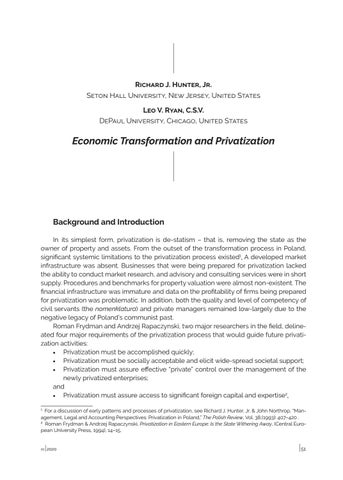Richard J. Hunter, Jr. Seton Hall University, New Jersey, United States Leo V. Ryan, C.S.V. DePaul University, Chicago, United States
Economic Transformation and Privatization
Background and Introduction In its simplest form, privatization is de-statism – that is, removing the state as the owner of property and assets. From the outset of the transformation process in Poland, significant systemic limitations to the privatization process existed1. A developed market infrastructure was absent. Businesses that were being prepared for privatization lacked the ability to conduct market research, and advisory and consulting services were in short supply. Procedures and benchmarks for property valuation were almost non-existent. The financial infrastructure was immature and data on the profitability of firms being prepared for privatization was problematic. In addition, both the quality and level of competency of civil servants (the nomenklatura) and private managers remained low-largely due to the negative legacy of Poland’s communist past. Roman Frydman and Andrzej Rapaczynski, two major researchers in the field, delineated four major requirements of the privatization process that would guide future privatization activities: •• Privatization must be accomplished quickly; •• Privatization must be socially acceptable and elicit wide-spread societal support; •• Privatization must assure effective “private” control over the management of the newly privatized enterprises; and •• Privatization must assure access to significant foreign capital and expertise2. 1 For a discussion of early patterns and processes of privatization, see Richard J. Hunter, Jr. & John Northrop, “Management, Legal and Accounting Perspectives: Privatization in Poland,” The Polish Review, Vol. 38,(1993): 407–420 . 2 Roman Frydman & Andrzej Rapaczynski, Privatization in Eastern Europe: Is the State Withering Away, (Central European University Press, 1994), 14–15.
|
|
xi 2020 51






